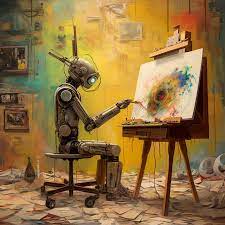Artificial Intelligence (AI) is revolutionizing the field of art, unlocking new creative possibilities, and challenging traditional notions of artistic expression. From generating art using neural networks to enhancing the creative process for artists, AI is reshaping how we create, interpret, and appreciate art. By harnessing the power of machine learning, generative algorithms, and computational creativity, AI is pushing the boundaries of artistic innovation and blurring the lines between human and machine creativity. Here’s a closer look at how AI is transforming the world of art and exploring its creative potential:
1. Generative Art
AI algorithms, such as Generative Adversarial Networks (GANs) and Variational Autoencoders (VAEs), can generate art autonomously by learning patterns and styles from large datasets of images, paintings, and artworks. These algorithms can produce visually stunning and conceptually rich artworks, ranging from abstract compositions to photorealistic landscapes, that challenge traditional notions of authorship and creativity.
2. Creative Collaboration
AI tools and platforms enable artists to collaborate with intelligent algorithms and machines, augmenting their creative process and expanding their artistic capabilities. Artists can use AI-driven software to explore new techniques, experiment with different styles, and generate novel ideas and concepts, fostering collaboration between human creativity and machine intelligence.
3. Artistic Exploration and Experimentation
AI allows artists to explore new realms of artistic expression and experimentation, pushing the boundaries of traditional art forms and techniques. From interactive installations and immersive experiences to algorithmic compositions and data-driven artworks, AI enables artists to create dynamic, multidimensional, and interactive artworks that engage audiences in novel ways.
4. Personalized Art Experiences
AI-powered algorithms can analyze individual preferences, tastes, and behavior to create personalized art experiences tailored to the unique interests and preferences of viewers. From recommending artworks based on user preferences to generating custom art pieces inspired by personal data, AI enables artists to create more personalized and meaningful connections with their audience.
5. Preservation and Restoration
AI technology plays a crucial role in preserving and restoring artworks, historical artifacts, and cultural heritage sites. Machine learning algorithms can analyze and interpret digital images of damaged or deteriorating artworks, enabling experts to digitally restore and reconstruct them with precision and accuracy, preserving their cultural and historical significance for future generations.
6. Ethical and Societal Implications
As AI becomes more integrated into the art world, it raises important ethical and societal questions about authorship, ownership, and the nature of creativity. Issues such as copyright, intellectual property rights, and the democratization of art creation and distribution require careful consideration and ethical oversight to ensure that AI-driven art remains ethical, inclusive, and respectful of human creativity and cultural diversity.
7. Future Directions
The future of AI and art holds tremendous promise for further exploration and innovation. As AI technologies continue to advance, we can expect to see even more sophisticated and nuanced forms of AI-generated art, as well as new opportunities for collaboration, expression, and engagement between humans and machines. The intersection of AI and art will continue to inspire creativity, spark dialogue, and challenge our perceptions of what it means to be creative in the digital age.
Conclusion
AI is reshaping the landscape of art, offering new tools, techniques, and possibilities for creative expression and exploration. From generative art and creative collaboration to personalized experiences and ethical considerations, AI is pushing the boundaries of artistic innovation and redefining the role of technology in the creative process. As AI continues to evolve, its impact on art will only grow, opening up new avenues for artistic experimentation, engagement, and appreciation in the digital age.

